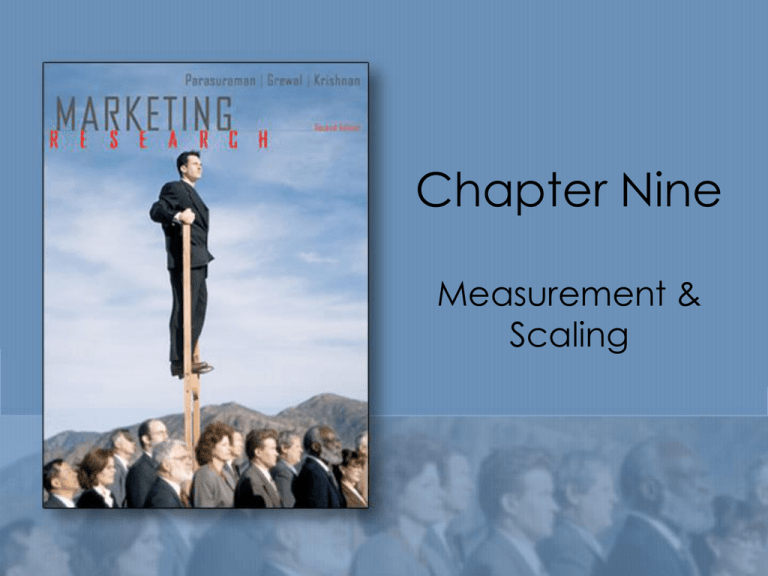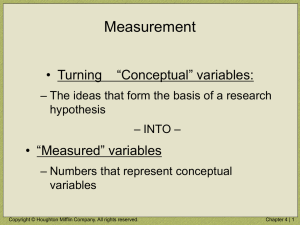
Chapter Nine
Measurement &
Scaling
Chapter Objectives
• Identify the four levels of measurement
under which numbers generated through a
survey can be classified.
• Distinguish among attributes, behavioral
variables, beliefs, and attitudes.
• List and describe five methods for inferring
people's attitudes.
Copyright © Houghton Mifflin Company. All rights reserved.
9|2
Chapter Objectives (Cont’d)
• Discuss the various dimensions on which
rating scales can vary.
• Apply the formats of Likert, semanticdifferential, and Stapel scales and discuss
how data generated by these scales are
analyzed and interpreted.
• Define validity, reliability, and sensitivity of a
scale.
Copyright © Houghton Mifflin Company. All rights reserved.
9|3
Harris Interactive:
U.S.Based Survey
Reputation Score of Top
Ten Corporations
Copyright © Houghton Mifflin Company. All rights reserved.
9|4
Harris Interactive: U.S. Based Survey Six
Dimensions of Reputation
Emotional Appeal
Financial
Performance
Products and
Services
Reputation
Workplace
Environment
Vision and
Leadership
Social
Responsibility
Copyright © Houghton Mifflin Company. All rights reserved.
9|5
20 Attributes of the Six Dimensions
Measured Using a 7 Point Scale
• Emotional Appeal
– Like
– Respect
– Trust
• Workplace Environment
– Well managed
– Appealing workplace
– Employee Talent
Copyright © Houghton Mifflin Company. All rights reserved.
9|6
20 Attributes of the Six Dimensions
Measured Using a 7 Point Scale (Cont’d)
• Products and Services
–
–
–
–
Innovative
Strong brand
Quality
Value
• Social Responsibility
– Citizenship
– Environmental stewardship
– Ethics
Copyright © Houghton Mifflin Company. All rights reserved.
9|7
Six Dimensions and Its Scales
• Vision and Leadership
– Clear values
– Strong leadership
– Inspiring vision
• Financial Performance
–
–
–
–
Growth prospects
Past results
Recognizes opportunities
Low risk
Copyright © Houghton Mifflin Company. All rights reserved.
9|8
Measurement
• Measurement is “the assignment of numbers
to observations [or responses] according to
some set of rules”
Copyright © Houghton Mifflin Company. All rights reserved.
9|9
Measurement Levels
•
•
•
•
Nominal
Ordinal
Interval
Ratio
Copyright © Houghton Mifflin Company. All rights reserved.
9 | 10
Nominal-Scaled Responses
• Numbers forming a nominal scale are no
more than labels used solely to identify
different categories of responses
• Example: What is your sex?
– Male
– Female
Copyright © Houghton Mifflin Company. All rights reserved.
9 | 11
Nominal-Scaled Responses (Cont’d)
• Which one of the following media influences
your purchasing decisions the most?
–
–
–
–
–
Television
Radio
Newspapers
Magazines
Internet
Copyright © Houghton Mifflin Company. All rights reserved.
9 | 12
Central Tendency– Mode
• The mode is the most frequent category only statistics applicable to nominal variable
Copyright © Houghton Mifflin Company. All rights reserved.
9 | 13
Ordinal-Scaled Responses
• An ordinal scale is more powerful than a
nominal scale in that the numbers possess
the property of rank order
• How long do you spend reading newspapers
on a typical weekday?
–
–
–
–
Less than 5 minutes
5 minutes to less than 15 minutes
15 minutes to less than 30 minutes
30 minutes or more
Copyright © Houghton Mifflin Company. All rights reserved.
9 | 14
Mode and Median
• The mode and the median are the most
meaningful measures of central tendency for
ordinal-scaled responses
• Median – the category in which the 50th
percentile response falls when all responses
are arranged from lowest to highest (or vice
versa)
Copyright © Houghton Mifflin Company. All rights reserved.
9 | 15
Consider the following distribution of responses to
the question about reading newspapers
• In this case, the mode is category 1, and the
median is category 2.
Response Category
Percentage of Respondents
Checking Category
1
40
2
25
3
25
4
10
Copyright © Houghton Mifflin Company. All rights reserved.
9 | 16
Interval-Scaled Responses
• An interval scale has all the properties of an
ordinal scale and the differences between the
scale values can be meaningfully interpreted
Copyright © Houghton Mifflin Company. All rights reserved.
9 | 17
Interval-Scaled Responses (Cont’d)
• How likely are you to buy a new automobile within the
next six months?
(Please check the most appropriate category.)
Will definitely not buy
Extremely unlikely
Unlikely
Likely
Extremely likely
Will definitely buy
Copyright © Houghton Mifflin Company. All rights reserved.
_____
(1)
_____
(2)
_____
(3)
_____
(4)
_____
(5)
_____
(6)
9 | 18
Exhibit 9.1 Impact of Arbitrariness of an
Interval Scale’s Starting Point
Copyright © Houghton Mifflin Company. All rights reserved.
9 | 19
Ratio-Scaled Responses
• Ratio scales possess all the properties of an
interval scale and the ratios of numbers on
these scales have meaningful interpretations
• What is your annual income before taxes?
$______
• How far is your workplace from your home?
_____ miles
Copyright © Houghton Mifflin Company. All rights reserved.
9 | 20
Classes of Variables
•
•
•
•
Attributes
Behavior
Beliefs
Attitudes
Copyright © Houghton Mifflin Company. All rights reserved.
9 | 21
Attitudes
• Attitudes are similar to beliefs, except that
they also involve respondents’ evaluative
judgments
• For instance, do respondents feel print
advertisements for cigarettes should be
banned?
Copyright © Houghton Mifflin Company. All rights reserved.
9 | 22
Attitudes –
Conceptually and Operationally
• A conceptual definition of attitude may be “a
predisposition to respond favorably or unfavorably to
a stimulus object”
• An operational definition of attitude refers to a
person’s attitude towards a particular retail store that
may be measured as the total of the person’s
expressed degree of agreement, on a 5-point,
“strongly agree” to “strongly disagree” scale, with
each of a set of 20 evaluative statements about
various aspects of the retail store
Copyright © Houghton Mifflin Company. All rights reserved.
9 | 23
Attitude Scaling
• Attitudes
– Widely believed to be a key determinant of behavior
– Can only be inferred and cannot be directly
ascertained
• Measures in which inferences are drawn from
–
–
–
–
Observed overt behavior
Individual's reaction
Performance on objective tasks
Physiological reactions
Copyright © Houghton Mifflin Company. All rights reserved.
9 | 24
Observing Overt Behavior
• Observation of overt behavior is useful when
other attitude measurement methods are
inconvenient or infeasible
• An observation study can be used to
ascertain the attitudes of very young children
toward a variety of toys
Copyright © Houghton Mifflin Company. All rights reserved.
9 | 25
Analyzing Reactions to Partially
Structured Stimuli
• Projective Techniques
– The approach of analyzing reactions to
partially structured stimuli involves asking
respondents to react to or describe in some
fashion, an incomplete, vague stimulus
Copyright © Houghton Mifflin Company. All rights reserved.
9 | 26
Evaluating Performance on
Objective Tasks
• To evaluate performance on objective tasks,
respondents are asked to complete an
ostensibly objective, well-defined task
• The nature of their performance is then
analyzed to infer their attitudes
Copyright © Houghton Mifflin Company. All rights reserved.
9 | 27
Monitoring Physiological Responses
• Monitoring physiological responses is based
on the premise that a person's emotional
reactions to a stimulus will be accompanied
by corresponding involuntary physiological
changes
Copyright © Houghton Mifflin Company. All rights reserved.
9 | 28
Self-report Measurements of Attitudes
• This method involves asking respondents
relatively direct questions concerning
attitudes toward whatever is of interest to the
researcher
• The questions are typically in the form of
rating scales on which respondents check off
appropriate positions that best reflect their
feelings
Copyright © Houghton Mifflin Company. All rights reserved.
9 | 29
Graphic Formats
• A graphic rating scale presents a continuum,
in the form of a straight line, along which a
theoretically infinite number of ratings are
possible
• Example: Indicate your overall opinion about
eBay by placing a mark at an appropriate
position on the line below.
Very
Bad
Copyright © Houghton Mifflin Company. All rights reserved.
Very
Good
9 | 30
Itemized Formats
• Itemized rating scales have a set of distinct
response categories
• Any suggestion of an attitude continuum
underlying the categories is implicit
• They essentially take the form of the multiplecategory questions
Copyright © Houghton Mifflin Company. All rights reserved.
9 | 31
Comparative Assessments
• Comparative Rating Scale
– Provides all respondents with a common
frame of reference
– Allows the researcher to be confident that all
respondents are answering the same question
Copyright © Houghton Mifflin Company. All rights reserved.
9 | 32
Non-comparative Assessments
• Non-comparative Rating Scale
– Implicitly permits respondents to use any
frame of reference or no frame of
reference at all
Copyright © Houghton Mifflin Company. All rights reserved.
9 | 33
Forced Response Choices
• A forced-choice scale does not give
respondents the option of expressing a
neutral or middle-ground attitude
Copyright © Houghton Mifflin Company. All rights reserved.
9 | 34
Forced Response Choices (Cont’d)
Indicate your overall opinion about eBay by checking one of the
following categories:
Very
Bad
Bad
[ ] [ ] [ ]
1
2
3
[
]
4
Neither Bad
Very
nor Good
Good
Good
[ ] [ ] [ ] [ ] [ ]
5
6
7
8
9
What is your overall rating of eBay in comparison with other
auction sites?
Much worse
( )
Worse About the same Better
( )
( )
( )
Copyright © Houghton Mifflin Company. All rights reserved.
Much better
( )
9 | 35
Non-forced Response Choices
• A non-forced-choice scale give respondents
the option to express a neutral attitude
Copyright © Houghton Mifflin Company. All rights reserved.
9 | 36
Non-forced Response Choices (Cont’d)
Indicate your overall opinion about eBay by placing a
mark in the category that best summarizes your feelings.
Very
Bad
[ ] [ ]
1
2
[
]
3
[
]
4
[ ]
5
[ ]
6
[
]
7
Very
Good
[ ] [ ]
8
9
What is your overall rating of eBay in comparison with other
auction sites?
Much worse
( )
Worse
( )
Copyright © Houghton Mifflin Company. All rights reserved.
Better
( )
Much better
( )
9 | 37
Balanced Response Choices
• A balanced scale is one that has an equal
number of positive/favorable and
negative/unfavorable response choices
Copyright © Houghton Mifflin Company. All rights reserved.
9 | 38
Balanced Response Choices (Cont’d)
Indicate your overall opinion about eBay by checking one of the
following categories:
Very
Bad
Bad
[ ] [ ] [ ]
1
2
3
[
]
4
Neither Bad
Very
nor Good
Good
Good
[ ] [ ] [ ] [ ] [ ]
5
6
7
8
9
What is your overall rating of eBay in comparison with other
auction sites?
Much worse
( )
Worse About the same Better
( )
( )
( )
Copyright © Houghton Mifflin Company. All rights reserved.
Much better
( )
9 | 39
Unbalanced Response Choices
• An unbalanced rating scale that can be used
if respondents’ opinions about a subject are
anticipated to be predominantly positive
Copyright © Houghton Mifflin Company. All rights reserved.
9 | 40
Labeled Response Choices
Copyright © Houghton Mifflin Company. All rights reserved.
9 | 41
Unlabeled Response Choices
Copyright © Houghton Mifflin Company. All rights reserved.
9 | 42
Exhibit 9.2 Rating Scales with
Picture Labels
Copyright © Houghton Mifflin Company. All rights reserved.
9 | 43
Number of Scale Positions
• A scale with a large number of positions will
not be meaningful if respondents are unable
to make fine mental distinctions with respect
to whatever is being measured
• More precise measurements should result as
the number of scale positions increase
Copyright © Houghton Mifflin Company. All rights reserved.
9 | 44
Paired Comparison Scale
• In each of the following pairs, which store do you
think is better?
(please check one online auction site within each pair)
_______ Amazon or_______ eBay
_______ eBay or
_______ Yahoo! Auction
_______ PriceLine.com or _______ eBay
_______ eBay or
_______ Ubid.com
Copyright © Houghton Mifflin Company. All rights reserved.
9 | 45
Commonly Used Multiple-item Scales
• Likert Scale
• Semantic-Differential Scale
• Stapel Scale
Copyright © Houghton Mifflin Company. All rights reserved.
9 | 46
Table 9.2 Likert Scale Items
1.
2.
3.
4.
5.
6.
Strongly
Disagree
Disagree
Neither
Agree nor
Disagree
Agree
Strongly
Agree
The online auction site
contains an abundance of exhibits
________
________
________
________
________
User registration
is complex at this site
________
________
________
________
________
The auction site commission
is reasonable
________
________
________
________
________
The auction site responds
to complaints quickly
________
________
________
________
________
The auction site is not
careful with personal information
________
________
________
________
________
The auction site support
system is confusing
________
________
________
________
________
Copyright © Houghton Mifflin Company. All rights reserved.
9 | 47
Exhibit 9.3 Semantic-Differential
Scale Items
Copyright © Houghton Mifflin Company. All rights reserved.
9 | 48
Exhibit 9.4 Pictorial Profiles Based on
Semantic-Differential Ratings
Copyright © Houghton Mifflin Company. All rights reserved.
9 | 49
Table 9.3 Stapel Scale
Abundanc
e of
Exhibits
Complex
User
Registration
Low
Commission
Good
Response
to
Complaints
Poor
Protection
of Personal
Information
Confusing
Support
System
+5
+5
+5
+5
+5
+5
+4
+4
+4
+4
+4
+4
+3
+3
+3
+3
+3
+3
+2
+2
+2
+2
+2
+2
+1
+1
+1
+1
+1
+1
-1
-1
-1
-1
-1
-1
-2
-2
-2
-2
-2
-2
-3
-3
-3
-3
-3
-3
-4
-4
-4
-4
-4
-4
-5
-5
-5
-5
-5
-5
Copyright © Houghton Mifflin Company. All rights reserved.
9 | 50
Strengths Of Multiple-Item Scales
• Validity
• Content validity
• Construct validity
• Predictive validity
• Reliability
• Test-retest reliability
• Split-half reliability
• Sensitivity
Copyright © Houghton Mifflin Company. All rights reserved.
9 | 51
Validity
• The validity of a scale is the extent to which it
is a true reflection of the underlying variable it
is attempting to measure
Copyright © Houghton Mifflin Company. All rights reserved.
9 | 52
Content Validity
• Face validity or content validity is the extent
to which the content of a measurement scale
seems to tap all relevant facets of an issue
that can influence respondents’ attitudes
Copyright © Houghton Mifflin Company. All rights reserved.
9 | 53
Exhibit 9.5 Types of Equivalence
Copyright © Houghton Mifflin Company. All rights reserved.
9 | 54
Construct Validity
• Construct Validity is the nature of the
underlying variable or construct measured by
the scale
Copyright © Houghton Mifflin Company. All rights reserved.
9 | 55
Predictive Validity
• Predictive Validity refers to how well the
attitude measure provided by the scale
predicts some other variable or characteristic
Copyright © Houghton Mifflin Company. All rights reserved.
9 | 56
Reliability
• Reliability measures how consistent or stable
the ratings generated by the scale are likely
to be
Copyright © Houghton Mifflin Company. All rights reserved.
9 | 57
Test-Retest Reliability
• Test-Retest Reliability measures the stability
of ratings over time and involves
administering the scale to the same group of
respondents at two different times
Copyright © Houghton Mifflin Company. All rights reserved.
9 | 58
Split-Half Reliability
• Split-Half Reliability measures the degree of
consistency across items within a scale and
can only be assessed for multiple-item scales
Copyright © Houghton Mifflin Company. All rights reserved.
9 | 59
Sensitivity
• Sensitivity focuses specifically on its ability to
detect subtle differences in the attitudes being
measured
Copyright © Houghton Mifflin Company. All rights reserved.
9 | 60







